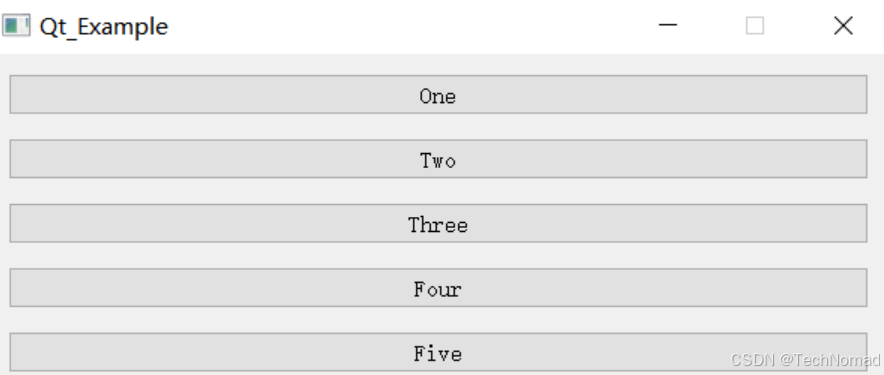一、QHBoxLayout介绍
QHBoxLayout是Qt框架中的一个布局管理器类,用于水平排列子部件。它是QLayout类的子类,用于在水平方向上自动调整和布局子部件的位置和大小。
二、QHBoxLayout的用法
以下是QHBoxLayout的一些特点和用法:
1.水平布局:QHBoxLayout将子部件按照水平方向从左到右进行布局。它可以自动调整子部件的位置和大小,使它们适应布局容器的大小变化。
2.添加子部件:通过调用QHBoxLayout的addWidget()函数,可以向布局中添加子部件。可以添加各种Qt部件,如按钮、标签、文本框等。
3.弹性空间:QHBoxLayout支持弹性空间的概念。通过在子部件之间添加弹性空间(addStretch()),可以实现在布局中分配额外的空间或者平均分配剩余空间。
4.对齐方式:可以使用setAlignment()函数设置子部件在布局中的对齐方式。可以指定水平和垂直方向上的对齐方式,如左对齐、右对齐、居中等。
5.嵌套布局:QHBoxLayout可以与其他布局管理器一起使用,以实现更复杂的布局。例如,可以将QHBoxLayout嵌套在QVBoxLayout中,以实现水平和垂直方向上的布局。
示例代码:
#include "main_window.h"
#include <QHBoxLayout>
#include <QPushButton>
MainWindow::MainWindow(QWidget *parent)
: QWidget(parent)
{
QPushButton *button1 = new QPushButton("One");
QPushButton *button2 = new QPushButton("Two");
QPushButton *button3 = new QPushButton("Three");
QPushButton *button4 = new QPushButton("Four");
QPushButton *button5 = new QPushButton("Five");
QHBoxLayout *layout = new QHBoxLayout;
layout->addWidget(button1);
layout->addWidget(button2);
layout->addWidget(button3);
layout->addWidget(button4);
layout->addWidget(button5);
layout->setAlignment(Qt::AlignTop);
this->setLayout(layout);
}

三、QHBoxLayout的常用函数
1.void QBoxLayout::setSpacing(int spacing)
功能: 设置布局中所有控件之间的默认间距。如使用setSpacing(15)将间距设置为15。
用途: 统一设置布局中元素之间的间距,而不是插入额外控件。
特点:
- 影响所有子控件之间的距离;
- 不添加额外空间,仅设置已有控件的默认间隔。
示例:
layout->setSpacing(15);

2.void QLayout::setContentsMargins(int left, int top, int right, int bottom)
设置外边距,将左、上、右、下的外边距设置为不同的值。
layout->setContentsMargins(30, 5, 5, 5);

3.void QBoxLayout::addStretch(int stretch = 0)
功能: 添加一个 可拉伸的弹性空间,默认 stretch = 0 表示一个标准拉伸因子。
用途: 用于让控件之间的间隔随窗口大小变化而自动伸缩,实现自动对齐。
特点:
- 空间会尽可能填充空白区域;
- 拉伸因子越大,占据空间越多;
- 常用于实现控件左对齐、右对齐、居中等。
居右添加伸缩:
QPushButton *button1 = new QPushButton("One");
QPushButton *button2 = new QPushButton("Two");
QPushButton *button3 = new QPushButton("Three");
QPushButton *button4 = new QPushButton("Four");
QPushButton *button5 = new QPushButton("Five");
QHBoxLayout *layout = new QHBoxLayout;
layout->addStretch();
layout->addWidget(button1);
layout->addWidget(button2);
layout->addWidget(button3);
layout->addWidget(button4);
layout->addWidget(button5);
layout->setAlignment(Qt::AlignTop);
this->setLayout(layout);

居中添加伸缩:
QPushButton *button1 = new QPushButton("One");
QPushButton *button2 = new QPushButton("Two");
QPushButton *button3 = new QPushButton("Three");
QPushButton *button4 = new QPushButton("Four");
QPushButton *button5 = new QPushButton("Five");
QHBoxLayout *layout = new QHBoxLayout;
layout->addStretch(); /* 第一个控件之前添加伸缩 */
layout->addWidget(button1);
layout->addWidget(button2);
layout->addWidget(button3);
layout->addWidget(button4);
layout->addWidget(button5);
layout->addStretch(); /* 最后一个控件之后添加伸缩 */
layout->setAlignment(Qt::AlignTop);
this->setLayout(layout);

如果在每一个控件之间都添加伸缩,那么所有的控件之间的间距都会相同。
QPushButton *button1 = new QPushButton("One");
QPushButton *button2 = new QPushButton("Two");
QPushButton *button3 = new QPushButton("Three");
QPushButton *button4 = new QPushButton("Four");
QPushButton *button5 = new QPushButton("Five");
QHBoxLayout *layout = new QHBoxLayout;
layout->addStretch();
layout->addWidget(button1);
layout->addStretch();
layout->addWidget(button2);
layout->addStretch();
layout->addWidget(button3);
layout->addStretch();
layout->addWidget(button4);
layout->addStretch();
layout->addWidget(button5);
layout->addStretch();
layout->setAlignment(Qt::AlignTop);
this->setLayout(layout);

4. void QBoxLayout::addSpacing(int size)
功能: 在布局中添加一个 固定大小的空白区域,单位是像素。
用途: 用于强制在控件之间插入固定宽度的间隔。
特点:空间是固定的,不能拉伸。
示例:
pLayout->addSpacing(20); // 插入 20 像素的空白
5. void QBoxLayout::addWidget(QWidget *widget, int stretch = 0, Qt::Alignment alignment = Qt::Alignment())
通常我们使用addWidget添加的控件都是默认垂直方向居中对齐的。其中有控件大小相同的时候就会看得不是很明显,一旦有不同于其他控件大小的控件出现,那么就会很明显的看出来,如下所示:

如果我们需要将其中的某些控件居上、居下显示,那么可以使用对齐方式Qt::Alignment。

QPushButton *button1 = new QPushButton("One");
QPushButton *button2 = new QPushButton("Two");
QPushButton *button3 = new QPushButton("Three");
button3->setFixedHeight(40);
QPushButton *button4 = new QPushButton("Four");
QPushButton *button5 = new QPushButton("Five");
QHBoxLayout *layout = new QHBoxLayout;
/* 水平居左 垂直居上 */
layout->addWidget(button1, 0, Qt::AlignLeft | Qt::AlignTop);
layout->addWidget(button2, 0, Qt::AlignLeft | Qt::AlignTop);
layout->addWidget(button3);
/* 水平居左 垂直居下 */
layout->addWidget(button4, 0, Qt::AlignLeft | Qt::AlignBottom);
layout->addWidget(button5, 0, Qt::AlignLeft | Qt::AlignBottom);
layout->setSpacing(15);
this->setLayout(layout);
6.void QBoxLayout::setDirection(QBoxLayout::Direction direction)
设置布局方向,可以设置从左到右、从右到左、从上到下、从下到上等。
layout->setDirection(QBoxLayout::RightToLeft);

layout->setDirection(QBoxLayout::TopToBottom);

7. void setMargin(int)
setMargin() 是 Qt 中布局类(如 QHBoxLayout, QVBoxLayout 等)早期版本中的一个函数,用于设置布局周围的外边距(Margin),即:布局与其父窗口或控件边缘之间的距离。
不过需要注意:setMargin() 已在 Qt 4 后被标记为过时(obsolete),推荐使用 setContentsMargins() 替代。
setMargin() 的作用(旧接口):
layout->setMargin(10);
表示设置布局上下左右的边距都为 10 像素。
等价于:
layout->setContentsMargins(10, 10, 10, 10);
推荐用法:setContentsMargins():
layout->setContentsMargins(左, 上, 右, 下);
layout->setContentsMargins(左, 上, 右, 下);
比如::
layout->setContentsMargins(10, 5, 10, 5);
表示左边距 10 像素,上边距 5,右边距 10,下边距 5。





















 3917
3917

 被折叠的 条评论
为什么被折叠?
被折叠的 条评论
为什么被折叠?








